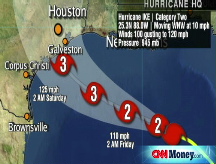Trade gap boosted by oil imports
Deficit grows more than expected. Reports also shows hints of economic weakness.
NEW YORK (CNNMoney.com) -- Record oil prices sent the trade deficit to a 16-month high in July, according to a government report released Thursday that also showed signs of economic weakness.
The Commerce Department reported that imports exceeded exports by $62.2 billion, up from an upwardly revised $58.8 billion in June. Economists had expected a $58 billion gap, according to a consensus estimate compiled by Briefing.com.
The gap was the widest since the $62.3 billion deficit posted in March 2007.
The report was strongly colored by oil prices, thanks to the $147.27-a- barrel record set July 11. Because the report is lagging, it doesn't reflect the more than 30% drop in oil prices over the past two months.
Excluding petroleum, the trade gap actually shrank to $29.6 billion from $32.5 billion in June, according to Bob Brusca, an economist with FAO Economics.
"If you strip oil out of the report, you see that imports are weak, exports are strong, and the deficit is shrinking," said Brusca. "Oil is a big misdirection as far as understanding the direction of trade."
Petroleum imports - which made up just under a quarter of the total - increased 13.7% from the month before, and were up nearly 31% from January. Oil helped raise overall imports to $230.3 billion from $221.6 billion, aided by the record $124.66 average price in July for a barrel of crude.
The month's imports of 342 million barrels of crude oil were the highest in four years, with total crude oil July imports reaching a record $42.6 billion.
The record $24.2 billion July deficit with OPEC marked a 33.7% increase from June, and a 124.1% increase from July 2007.
Although there was a small increase in inflation-adjusted, non-petroleum imports, they remained below levels reached earlier this year - a signal to Brusca that the economy is in decline.
"Declining imports are a harbinger of bad GDP results and bad domestic demand," Brusca said.
The increases in imports, aside from petroleum, came from capital goods, and the foods, feeds and beverages category.
Exports rose to $168.1 billion from $162.8 billion in June. Export categories with the strongest growth included industrial supplies, capital goods, autos and consumer goods. There were slight declines in the feeds, food and beverages category.
The trade gap with China increased 16.4% in July, to $24.9 billion from $21.4 billion. On a year-to-year basis, the gap has widened by 4.6%. ![]()


